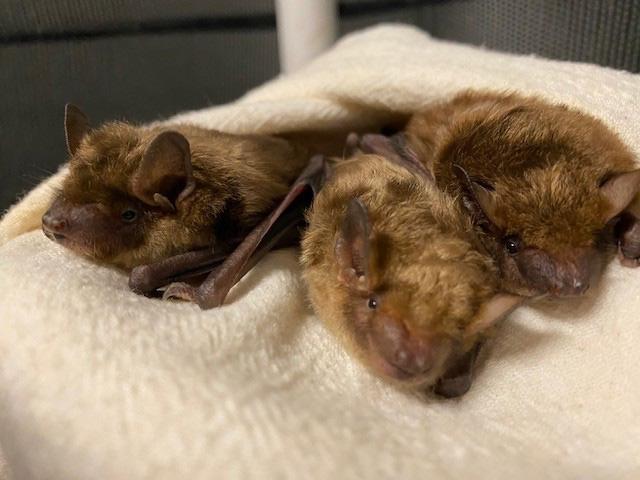
CMC Blog
Going Batty in Cincinnati
By: Emily Eilers, DVM, a current volunteer in the Animal Resources Department at Cincinnati Museum Center and a Masters Degree student in Project Dragonfly at Miami University
As I enter the Free-Flight cage, I hear the angry squeaks of big brown bats (Eptesicus fuscus) fighting over space under the towels that hang from the top of the enclosure. I pinpoint the direction that the squeaks are coming from, lift up the towel and say good morning to some of the resident big brown bats that call Cincinnati Museum Center home. Some people, like me, think bats are cute, while others believe that they are scary. So, no matter which way you look at them, what is the truth behind these denizens of the dark?

Big brown bats are just one of over 1,400 bat species found all over the world. This makes them the second largest order of mammals in the world, just behind rodents. Bats belong to the order Chiroptera, which means “hand wing.” Their wings are composed of a thin layer of skin stretched between their arms, elongated fingers and legs. Due to this adaptation, bats are the only mammal that are capable of true and sustained flight.

If you look up towards the sky at dusk during the summer or fall, you will more than likely see one or several big brown bats flying above your head as they search for a snack of yummy insects. Big brown bats are the most common of the roughly ten microbat (small bats with small eyes, large ears and eat mostly insects) species which call Ohio home. Some of their relatives include the endangered Indiana bat, tricolored bat, northern long-eared bat and little brown bat. These species and others have decreased in number due to loss of habitat, decreased food sources, climate change, persecution, wind turbines and the fungus, Pseudogymnoascus destructans (Pd), which causes White Nose Syndrome. Pd grows on the bats’ muzzles and wings and causes them to wake early from their hibernation torpor (or sleep). When the bats wake, they use their energy stores and without food sources during the winter, die from starvation. Pd spreads very rapidly between bats in the caves but can also be spread by humans that visit the caves. If you do enjoy caving, you need to make sure that you bring a change of clothes and boots so that you are not unknowingly spreading the disease.
Due to the major declines in bat populations over the years, researchers have been closely monitoring population numbers. One of the ways that researchers have been studying bats is through acoustic monitoring surveys. Acoustic monitoring uses the bats’ echolocation, or the ultrasonic sound waves that bats produce to help them navigate and find food. The sound waves bounce off objects and return to the bats’ ears which allows them to determine the distance between themselves and the object. Each bat species has their own distinct echolocation and by using a special machine, called a bat detector, researchers can see and hear the differences between the calls to determine the number and species of bats present in an area. By monitoring numbers over time, they have been able to see declines and rebounds of populations across the state.
So, you ask, what’s the big deal with bats? Why should I care about them? Well, there are multiple reasons why bats are beneficial to you and the environment. First, they are a major source of insect control. The main diet of Ohio bats are insects, and each bat can eat up to 1,000 mosquitos in one hour. This saves the US $3.7 billion dollars in pest control annually. Think about the amount of pesticides that would be used on crops and insects yearly if we did not have bats! Also, bats help to pollinate plants and spread seeds. How many of you enjoy tequila in your mixed drinks? You can thank bats for that as they help to pollinate the agave plant in South America. Additionally, bat guano (or poop) is a great fertilizer for plants. Bats can even serve as indicators of water quality!
What can you do to help save them? Great question! Here are a few things that you can do:
- Spread the word to your family and friends and let them know how great bats are!
- Encourage your representatives in the House and Senate to pass legislation, such as Recovering America’s Wildlife Act (RAWA), which supports conservation efforts.
- Participate in acoustic monitoring studies to help monitor local bat populations, such as the North American Bat Monitoring Program (NABat) or bat monitoring program through the Ohio Department of Natural Resources.
- Build and put up bat houses on your property.
- Plant bat gardens to attract food and provide shelter for bats. Bat Conservation International has great resources on DIY projects to help bats.
- Leave old trees alone as bats roost in the hollowed out portions of the trees during the summer.
- If you encounter a bat, especially in your home, do not try to handle it. Call an animal removal company.
For more information about Bat Conservation International, visit their website at www.batcon.org. For more information on NABat, visit their website at http://www.nabatmonitoring.org/. For more information on the bat monitoring program through the Ohio Department of Natural Resources, visit their website at http://ohiodnr.gov/discover-and-learn/safety-conservation/wildlife-management/bats-acoustic-surveys.

Museum Admission
Includes Cincinnati History Museum, Museum of Natural History & Science and The Children's Museum
| Adult: | $24.25 |
| Senior: | $17.00 |
| Child: | $17.00 |
| Member Adult: |
FREE |
| Member Child: |
FREE |
Members receive discounts!
Become a Member today to save on programs, exhibits and films throughout CMC.
Museum Hours
Open Thursday – Monday
10 a.m. to 5 p.m.
Closed Tuesday and Wednesday
Closed Thanksgiving Day and Christmas Day
Member’s-only early entry: Saturdays at 9 a.m.
Customer Service Hours:
Monday – Sunday, 9 a.m. to 5 p.m.


